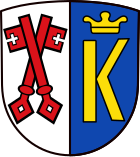Genderkingen
| coat of arms | Germany map | |
|---|---|---|

|
Coordinates: 48 ° 42 ' N , 10 ° 53' E |
|
| Basic data | ||
| State : | Bavaria | |
| Administrative region : | Swabia | |
| County : | Danube Ries | |
| Management Community : | Rain | |
| Height : | 399 m above sea level NHN | |
| Area : | 11.67 km 2 | |
| Residents: | 1202 (Dec. 31, 2019) | |
| Population density : | 103 inhabitants per km 2 | |
| Postal code : | 86682 | |
| Area code : | 09090 | |
| License plate : | DON, Lower Austria | |
| Community key : | 09 7 79 149 | |
| LOCODE : | DE GNK | |
| Community structure: | 8 parts of the community | |
| Address of the municipal administration: |
Main street 2 86682 Genderkingen |
|
| Website : | ||
| Mayor : | Leonhard Schwab ( Free Citizens ) | |
| Location of the community of Genderkingen in the Donau-Ries district | ||
Genderkingen is a municipality in the Swabian district of Donau-Ries .
The capital is 37.6 km north of Augsburg and near the confluence of the Lech and the Danube.
geography
Community structure
The municipality has eight officially named municipality parts (the type of settlement is indicated in brackets ):
|
|
Places in the area
- Donauwörth
- Rain
- Niederönenfeld
- Neuburg on the Danube
- Asbach-Bäumenheim
- Mertingen
- Wemding
- Oberndorf am Lech
history
The place was probably founded between the 5th and 7th centuries and the village itself quickly developed into a border town with old Bavaria . On April 29, 1478, the village came into the possession of the Cistercian monastery Kaisheim . In 1803 the community was incorporated into the Kingdom of Bavaria as part of the secularization of the Kaisheim monastery .
The end of World War II was marked in Genderkingen by the invasion of American soldiers on April 25, 1945.
Population development
Between 1988 and 2018 the community grew from 1,058 to 1,198 by 140 inhabitants or 13.2%.
Culture and sights
- Catholic parish church of St. Peter and Paul , site of the early work of the rococo painter Johann Baptist Enderle .
- The village square between the church and town hall has been redesigned with a "water ribbon".
Architectural monuments
Soil monuments
Economy and Infrastructure
Jobs
In 2016 there were 328 jobs subject to social security contributions (2011: 478). 520 of the residents were in employment subject to social insurance contributions, so that 192 more people commuted out and in.
traffic
The place Genderkingen has a direct connection to the B 16 and is approx. 3 km away from the B 2 . There is a train station on the Ingolstadt – Neuoffingen railway line and the Donauwörth-Genderkingen special airfield .
education
In Genderkingen there is a kindergarten with 50 seats (2015: 37 children) and a branch of the Johannes-Bayer - Elementary School Rain.
Public facilities
There is a volunteer fire brigade in the main town of Genderkingen .
religion
The Catholic parish Saint Peter and Paul belongs to the parish community Rain in the deanery in Donauwörth in the diocese of Augsburg . In addition, the wasteland of Wörthen , in the area of the municipality of Niederschönenfeld, belongs religiously to Genderkingen.
politics
The community is a member of the Rain administrative community .
mayor
- 1900–1930 Johann B. Wanner
- 1930–1933 Michael Liedl
- 1933–1945 Franz Xaver Königsdorfer
- 1945–1948 Michael Liedl
- 1948–1972 Andreas Voag
- 1972–1978 Reinhold Hofmann
- 1978–2008 Johann Schilke
- 2008–2020 Roland Dietz CSU
- since May 1, 2020: Leonhard Schwab (Free Citizens Genderkingen)
Municipal council
Occupation from May 1, 2020
- Free Citizens Genderkingen: 9 seats
- We for Genderkingen: 3 seats
Local election on March 16, 2014
- Free Citizens Genderkingen: 6 seats
- We for Genderkingen: 6 seats
Municipal coat of arms
The coat of arms is split in silver and blue. In front there are two diagonally crossed red keys (for the patronage of the parish church St. Peter and Paul), behind the golden crowned golden capital letter K (for the former affiliation to the Kaisheim monastery).
Personalities
- Franz Anton Bieger (born November 27, 1833 in Burgebrach , † April 23, 1907 in Genderkingen), village pastor and composer of church works
literature
- Gabriele Schwab, Kurt Latzel and Werner Geillinger: Genderkingen - From the life of a village , Rain 1995 (publisher: Raiffeisenbank)
- Richard Dertsch : The German settlement of eastern Bavarian Central Swabia presented in its historical features , in: Archive for the history of the Hochstift Augsburg Vol. VI (1929), pp. 297–432, here especially p. 383 ff. Regarding the wastelands near Genderkingen (Schwaighöfe).
Web links
Individual evidence
- ↑ "Data 2" sheet, Statistical Report A1200C 202041 Population of the municipalities, districts and administrative districts 1st quarter 2020 (population based on the 2011 census) ( help ).
- ^ Community Genderkingen in the local database of the Bayerische Landesbibliothek Online . Bayerische Staatsbibliothek, accessed on September 3, 2019 .. There nine parts of the municipality, as one part of the municipality Genderkingen Bahnhof is listed, but which does not exist (any longer).
- ↑ Mayor & Town Hall. Community of Genderkingen, accessed on July 18, 2020 .
- ↑ Biographical information on the website of the community ( memento of the original from November 1, 2013 in the Internet Archive ) Info: The archive link was inserted automatically and has not yet been checked. Please check the original and archive link according to the instructions and then remove this notice.




